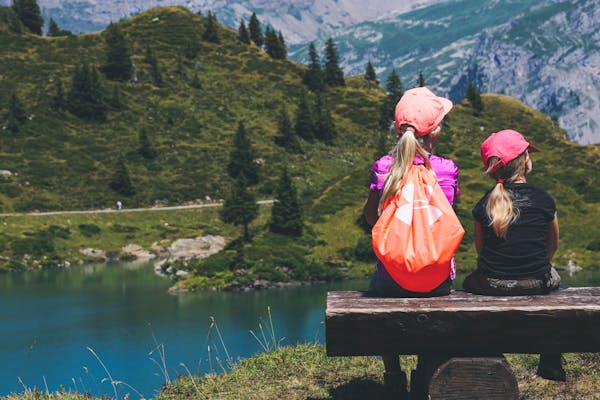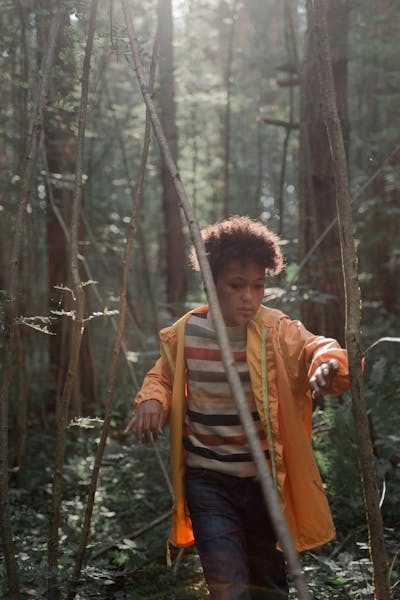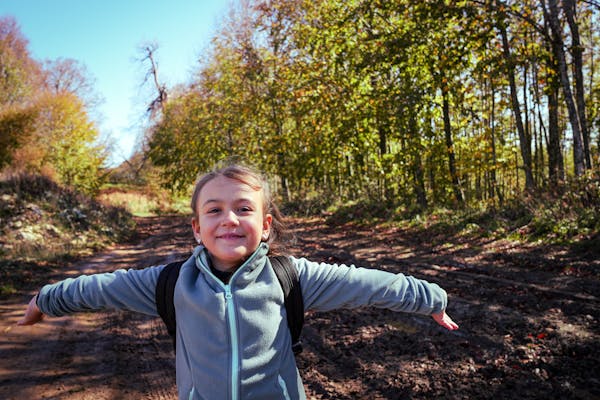
Hiking is a wonderful way to connect with nature, get some exercise, and share an experience that everyone in the family can enjoy. If you’re planning to hit the trails with young adventurers (ages 5-12), this guide will help you prepare for a safe, fun, and memorable outing. Whether you’re an experienced hiker or just starting out, these safety tips for hiking with children will set you up for success on your family hikes!
Get Kids Involved in the Planning
Start building excitement by involving your kids in the planning. Show them the map, talk about where you’re going, and ask for their input on what activities they’d like to do. Giving them a say makes them feel part of the adventure and can boost their enthusiasm. It also an opportunity to teach them the basics of map reading. My guide on how to plan a hike is a must read.
- Tip: Keep the planning process simple and fun. Use visual aids like a map to show them landmarks you’ll pass, such as waterfalls or large trees, so they can mentally picture the route.

Choose a Manageable Distance
When hiking with kids, it’s important to pick a distance that matches their age, energy levels, and experience. For younger kids or beginners, aim for hikes under 3 km. Remember, it’s more about the journey than the destination. Frequent breaks and time to explore the surroundings will keep them engaged and energized.
- Tip: If you find yourself answering “Are we there yet?” too many times, consider shortening your distance next time or exploring side trails along the way.
Distribute the Load
Kids love feeling like they’re part of the team, so let them carry a few small, age-appropriate items. A light backpack with a jacket, snack, or small water bottle can make them feel involved. Just be sure not to overload them—the key is keeping it light and fun.
- Tip: If you have multiple kids, assign each one a small role, like carrying part of lunch or being in charge of snacks. Getting them involved will help keep them interested.
Dress Kids in Bright Colors
Brightly colored clothing not only makes for fun photos but also helps kids stand out if they wander too far or if you need to keep track in a crowded area. Bold colors improve visibility and make it easier to stay together as a group.
- Tip: Bright jackets, hats, or backpacks are great for this. Choose colors that stand out in natural settings, like orange or neon green.

Establish Ground Rules
Setting some simple ground rules can go a long way in keeping everyone safe. For younger kids, remind them to stay within sight. For older children, establish boundaries, like stopping at any trail junctions or waiting in confusing areas. Safety rules help kids understand their limits while allowing them to explore with confidence.
- Tip: Engage kids by practicing “what if” scenarios in a lighthearted way. Role-playing can help reinforce safety in a way that feels like a game, making them less likely to feel fearful.
Share the Lead
Kids love taking charge, so let them lead sections of the hike. This makes them feel like they’re “in control” and keeps them focused. Break the hike into short segments, such as reaching a specific tree or stream, and allow them to take turns leading the group to each point.
- Tip: While they’re in the lead, encourage them to spot interesting things to share with the group, like unique plants or animal tracks. This can also help slow their pace if they’re tempted to run ahead.
Prepare for Weather Changes
Weather can change quickly, so pack extra layers for everyone. For kids, include a warm jacket, rain gear, and even a spare pair of socks. Being ready for sudden changes helps keep everyone comfortable and happy on the trail.
- Check the weather before you leave home on the day of your hike and pack accordingly, but always bring one extra layer per person, even on warmer days.
Pack Extra Food and Water
Kids tend to burn a lot of energy when hiking, so bring extra snacks and water to keep them fueled. Hydration is especially important, so plan for breaks to drink water regularly. Pack more than you think you’ll need—growing kids can surprise you!
- Tip: Encourage kids to carry their own small water bottle and take breaks together for “family hydration time.” Doing this teaches them to keep their hydration up.
Carry a First Aid Kit (and Know How to Use It)
A basic first aid kit is essential for any family hike. Include items like bandages, antiseptic wipes, tweezers, and pain relievers. Familiarize yourself with basic first aid skills, and consider teaching older kids how to handle simple injuries. Small kits can be personalized for each child, so they feel ready for the trail.
- Tip: Involve kids by letting them carry a mini first-aid kit or showing them how to use a bandage. Knowing they’re prepared can build confidence.
Teach Kids What to Do if Lost
One of the most valuable lessons is teaching kids what to do if they get separated. Practice the “Hug a Tree” method: if they realize they’re lost, they should stop, stay in one place, and blow a whistle three times to signal for help.
- Tip: Make sure each child has a whistle and practice this drill at home. Reinforce the importance of staying on the trail and waiting for help to arrive.
Assign an “It” for Supervision
It’s easy to get lost in the scenery when hiking, so take turns being the designated “It”—the person responsible for keeping an eye on the kids. By rotating this role, each adult gets time to relax while ensuring everyone’s safety.
- Tip: Pass the responsibility verbally when switching roles to ensure everyone knows who’s currently “on duty.”
Be Flexible and Embrace the Adventure
Above all, keep the mood light and embrace the unexpected. Hiking with kids can come with surprises, from minor mishaps to unexpected detours. Laugh off small setbacks and celebrate each milestone on the trail.
- Tip: Bring a sense of humor and adjust to their interests. If they’re fascinated by a bug or curious about every leaf, indulge their curiosity. Hiking is about experiencing nature together, so make it enjoyable for everyone.

Respecting Nature
Respecting nature is a great lesson for kids on a hike, helping them build a sense of environmental responsibility. Encourage them to see how their actions, like picking up litter or staying on marked trails, help protect plants and animals. It’s a simple way to instill environmental awareness early on. My hiking etiquette guide will set you on the right path.
- Tip: Make it a game! Challenge kids to spot trash (or things that shouldn’t be touched) and talk about why leaving nature as it is keeps the trail healthy for everyone, including future hikers.
Final Thoughts
Hiking with kids is a fantastic way to introduce them to the outdoors, build their confidence, get them active and off devices, and create cherished family memories. With a little planning and flexibility, you can turn each hike into a fun and safe adventure they’ll look forward to. By following these tips, you’ll set yourself up for success on the trail and spark a love of nature that can last a lifetime. Happy Hiking!
If you have any experiences you would like to share or questions, please leave them below.

I am from Australia and have been looking for some ideas on how to safely take my children on bush hikes with my husband and I.
I love that you have added in ideas from getting the children involved with planning to getting them involved with the first aid.
I am interested as to if you have any experience with kid friendly trail maps so that we can teach our children how to follow a map if they are lost?
This article provides important safety and security suggestions for parents hiking with children. I admire the extensive insurance coverage of vital prep work such as selecting appropriate routes and packaging required tools, along with the emphasis on educating youngsters regarding outside security. Being a hiking enthusiast and parent myself, I comprehend the significance of focusing on the safety and wellness of youngsters. Your tips to keep a constant speed and guarantee everyone stays hydrated are specifically informative.
I wonder concerning approaches for dealing with differing power degrees while treking with children of different ages. It can be challenging to maintain everybody interested and avoid fatigue, so I have an interest in finding out more regarding how to prepare walks with younger youngsters or newbies in mind. Additionally, I wish to recognize some pleasurable tasks to keep kids captivated throughout longer walks.
On the whole, this blog post gives important insights into making hiking with children not only risk-free however enjoyable for everybody. I’ll absolutely be using your suggestions for our following household walk. Thanks for sharing such thoughtful suggestions!
Thanks for the feedback. It’s hard when you have hikers with different abilities. You could let those that want to go ahead go with one parent and the slower ones stay with another but it’s important to frequently stop and wait for all to catch up. I don’t recommend groups splitting up. If there is a big difference in ability, then you really need to cater the walk to those with the lowest ability, otherwise it can become dangerous for all. It’s unfair to expect a 5 year old to do a 20 km hike. The older kids just need to learn that it’s a group activity and it’s about ensuring the hike is safe for everyone.